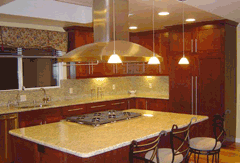
There is no agreed-upon method specifically for measuring radon or radiation from granite countertops. Direct measurements in a building of the gamma radiation or radon emanation from a material, such as granite, is not a reliable indicator of radon concentrations that will be in the air you breathe. Attempts to use such measurements for estimating risk are subject to large errors due to the:
a) wide variability of radon emanation rates across the surface of granite.
b) significant variability in ventilation rates from home to home and room to room.
c) volume of space that the building material is contained in. |
Easy diagnostic test procedure for granite countertops:
At the same time, proceed to:
A) Conduct a radon test in the lowest level of the home as per normal EPA recognized protocols.
B) Conduct another test in the room where the granite countertop or other suspect building material exists. Place this test device at least 20 inches away from the countertop or suspect material. Otherwise this test as per normal EPA recognized protocols such as at least 20 inches off the floor.
C) Conduct another test in a different room on the same floor where the granite countertop or suspect material exists.
Compare these results to determine:
- If radon from the soil needs to be mitigated. If so, retest in the above fashion after soil air mitigation.
- If concentrations are higher near the granite. If so, additional diagnostics are needed to insure the building material is truly a problem. You may wish to seek additional information at such a juncture from your State Radon Program or through the USEPA.
|